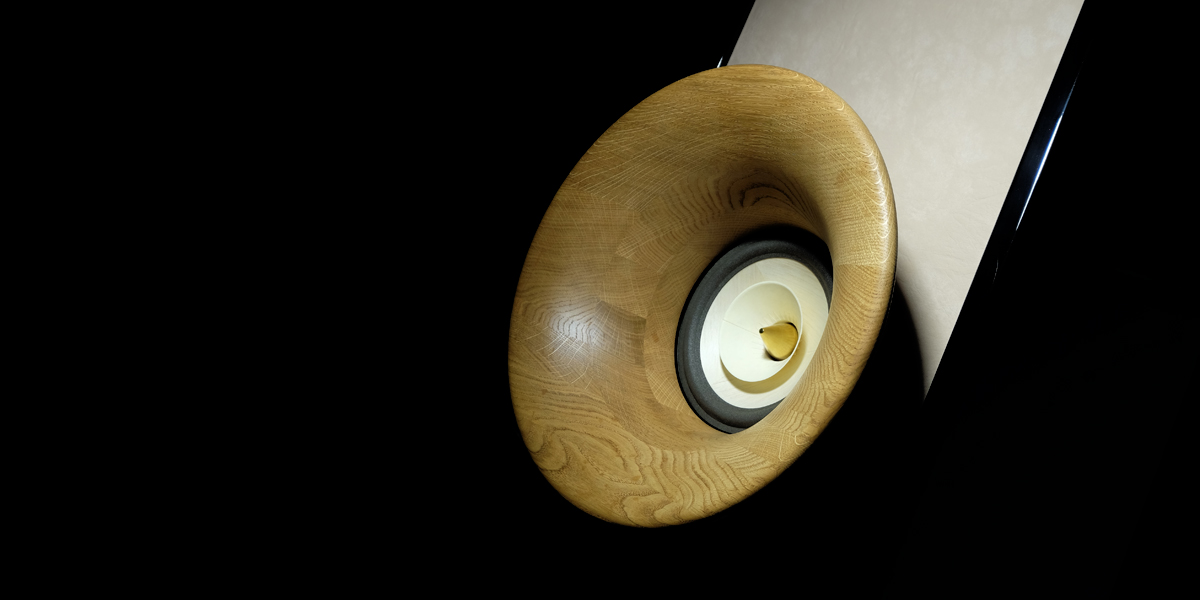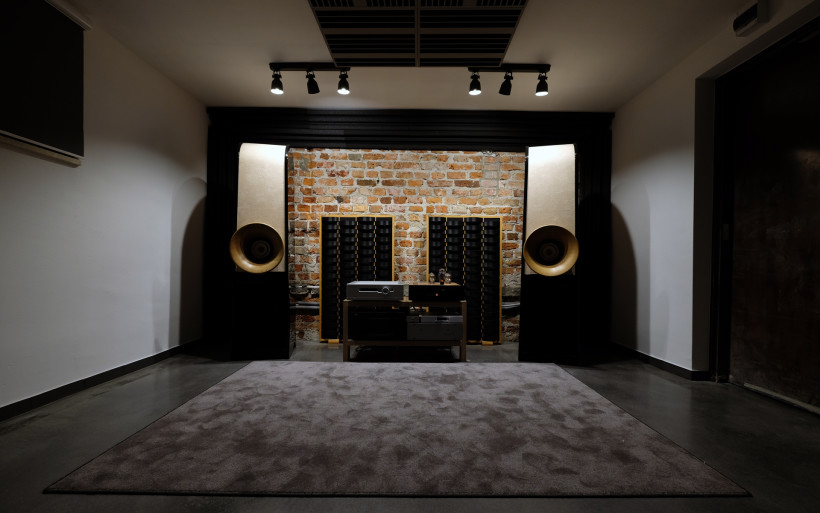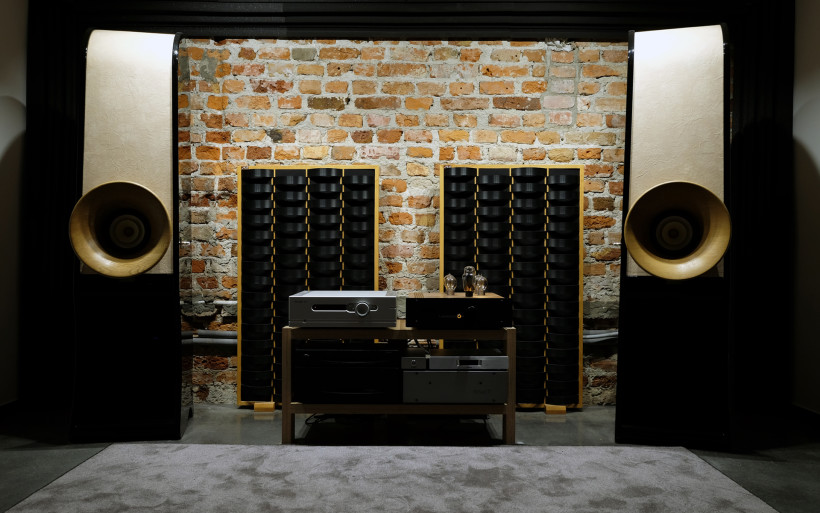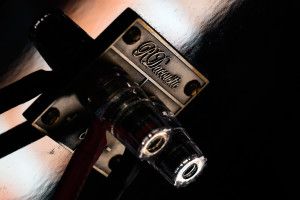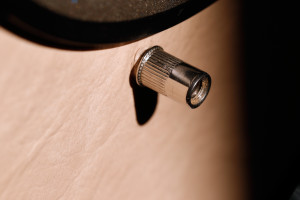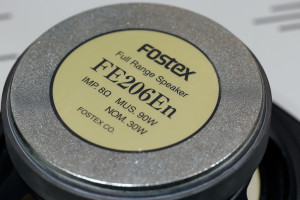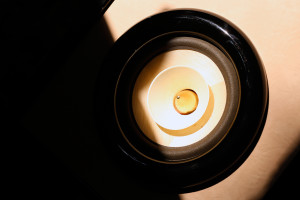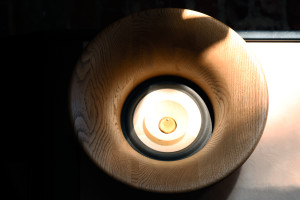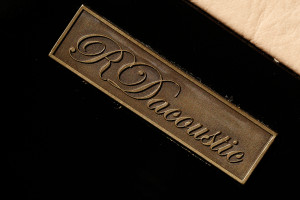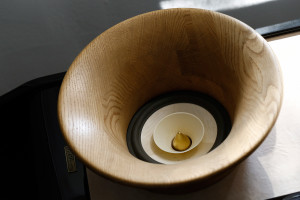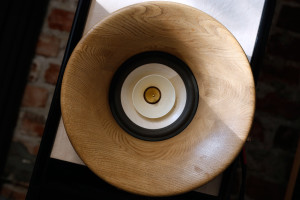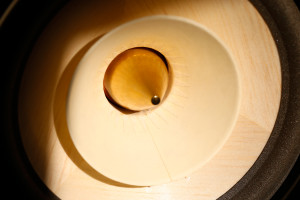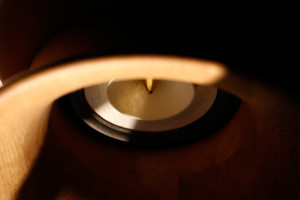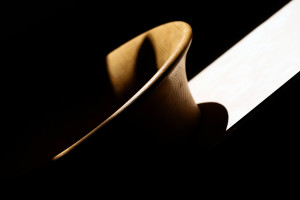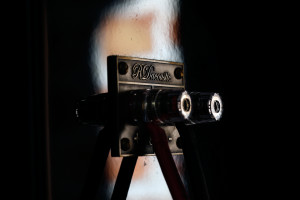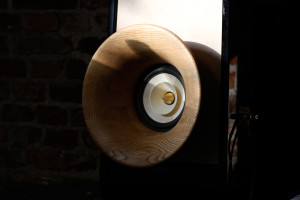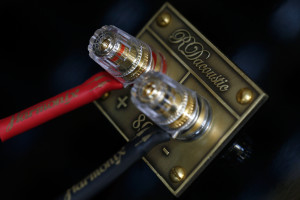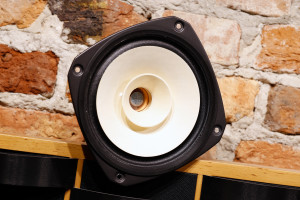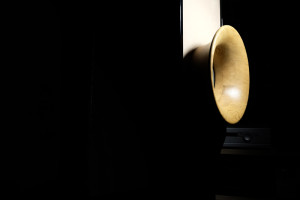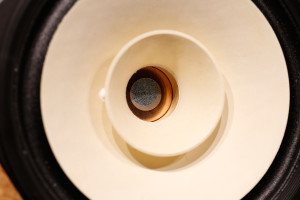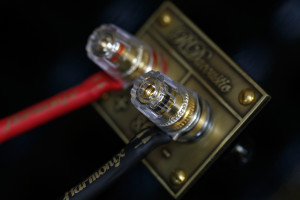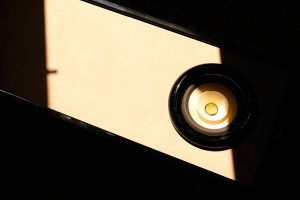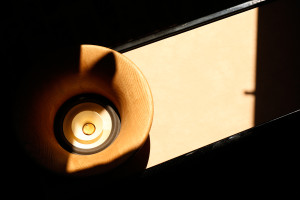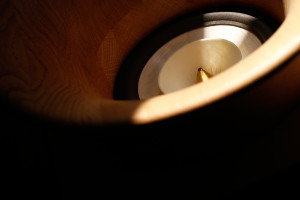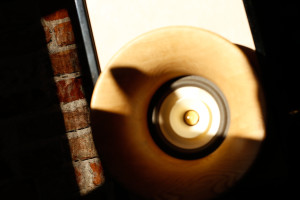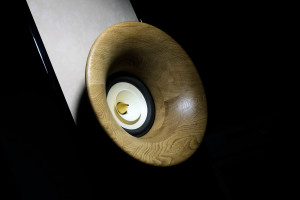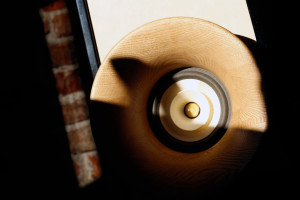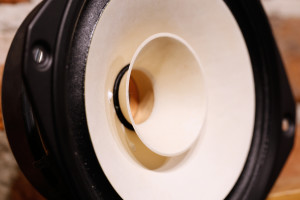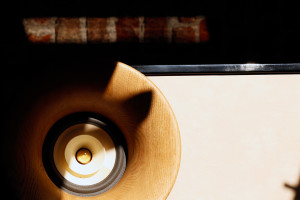Exceptionally big cabinet, merely one transducer, high efficiency, steep price tag and all that served by an unknown newcomer from Czech Republic. What can go wrong? Possibly everything, yet this remains to be seen. RDacoustic Evolution is this review’s main dish and to answer the question above, one has to try it first. Enjoy.
Introduction
I’ve stumbled upon RDacoustic brand two times. The first one was during this year’s High End Munich expose. Said newcomer had a rather small booth somewhere in the middle of one of four halls. Usually that’s the place reserved for open stands. Truth be told, closed spaces are not exactly rare there, but uncommon nonetheless. Practice often shows that sound quality inside makes one wonder why to actually bother and try to fit in such restrictive frame, if it’s known from the very beginning that the outcome will be off. Instead of showing up no matter what, it might be a better idea to wait and grab a room upstairs twelve months later. Point being, what ought to be a successful presentation, can turn out to be plainly bad because of acoustically hostile environment. In most cases it never works in exhibitors’ favour, that’s not a secret knowledge. Point being, from this journalist’s perspective to wait is often the smartest play.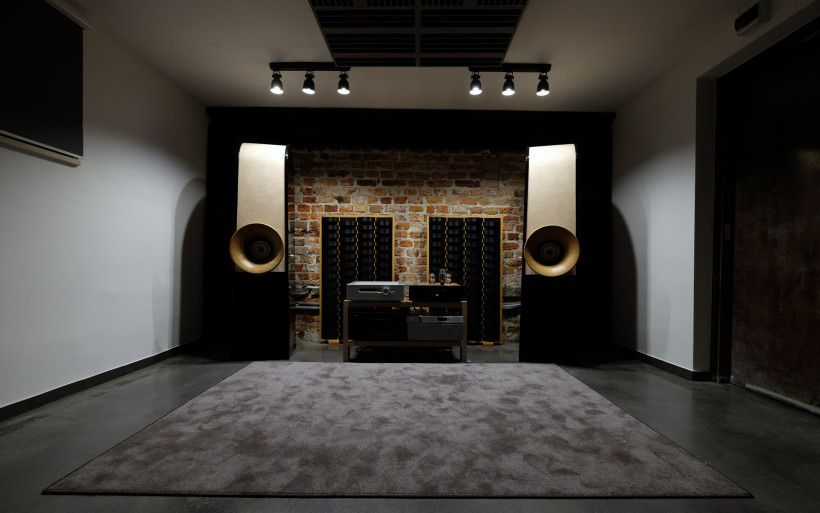 Journalistic thinking aside, some manufactures simply can’t wait any longer. Another year without proper recognition can be a rather grim scenario. Income has to appear on the horizon at some point and Munich presence is said to be one of the best measures to achieve that. It’s unknown whether RDacoustic guys had to be present at this year’s German event no matter what, or they simply wanted to. That’s of no importance now. What counts is that they were there, in a small booth, with loudspeakers rarely this big. On paper, this couldn’t work to their advantage, could it? To be honest, I haven’t spent too much time in RDacoustic room. Personal roadmap included places and people I’m familiar with in the first place. And since time wasn’t on my side, mere several hours is what’s left to cover extensive rest. But I took a peek inside Czech room nonetheless. Exceptionally big Evolution floorstanders were the main dish there, at least in this journalist’s eyes. I expected the sound to literally rip the place apart, yet nothing of this sort happened. Curiosity kicked-in instead as said presentation was at least promising. Let’s fast forward a bit.
Journalistic thinking aside, some manufactures simply can’t wait any longer. Another year without proper recognition can be a rather grim scenario. Income has to appear on the horizon at some point and Munich presence is said to be one of the best measures to achieve that. It’s unknown whether RDacoustic guys had to be present at this year’s German event no matter what, or they simply wanted to. That’s of no importance now. What counts is that they were there, in a small booth, with loudspeakers rarely this big. On paper, this couldn’t work to their advantage, could it? To be honest, I haven’t spent too much time in RDacoustic room. Personal roadmap included places and people I’m familiar with in the first place. And since time wasn’t on my side, mere several hours is what’s left to cover extensive rest. But I took a peek inside Czech room nonetheless. Exceptionally big Evolution floorstanders were the main dish there, at least in this journalist’s eyes. I expected the sound to literally rip the place apart, yet nothing of this sort happened. Curiosity kicked-in instead as said presentation was at least promising. Let’s fast forward a bit.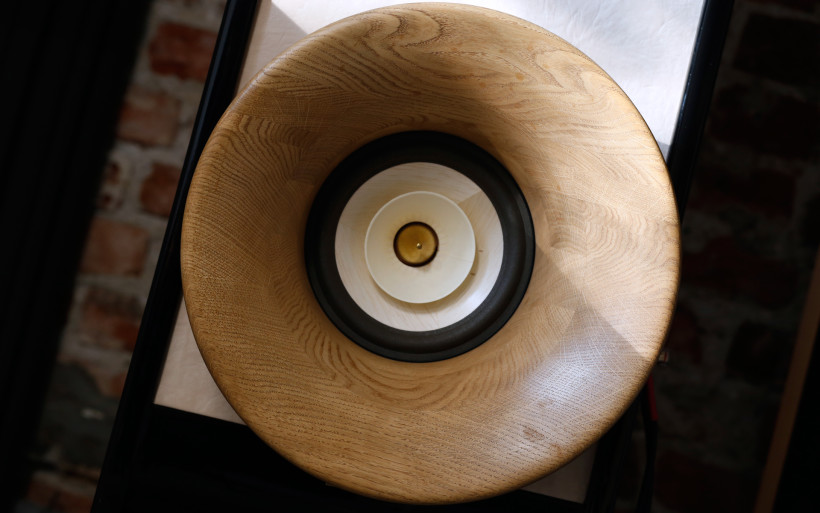 Shortly after Munich expo ended, 6moons.com Evolution article arrived. Quite a read, please take a look here. As per usual, Srajan’s work is full of tasty details about RDacoustic manufacture, its goals, the design itself, its sound profile and – what’s the most important – gear combinations that worked for said gent. Some days later, a mail from Srajan came and Martin Landa – RDacoustic marketing man – was cc’ed. What happened next is no mystery. Our Czech company was and perhaps still is in search of additional brand recognition, hence this Evolution review was born. Easy peasy, or is it? This journalist had lots of doubts. Firstly, said floorstanders are plainly big, on the contrary to my listening room. Secondly, logistics. To handle about 150 kilograms in total is at least two men job. Thirdly, size again, it’s scary. I kid you not, it is. And lastly, all that at once. Some things weren’t meant to be, eh? No quite, at least not this time.
Shortly after Munich expo ended, 6moons.com Evolution article arrived. Quite a read, please take a look here. As per usual, Srajan’s work is full of tasty details about RDacoustic manufacture, its goals, the design itself, its sound profile and – what’s the most important – gear combinations that worked for said gent. Some days later, a mail from Srajan came and Martin Landa – RDacoustic marketing man – was cc’ed. What happened next is no mystery. Our Czech company was and perhaps still is in search of additional brand recognition, hence this Evolution review was born. Easy peasy, or is it? This journalist had lots of doubts. Firstly, said floorstanders are plainly big, on the contrary to my listening room. Secondly, logistics. To handle about 150 kilograms in total is at least two men job. Thirdly, size again, it’s scary. I kid you not, it is. And lastly, all that at once. Some things weren’t meant to be, eh? No quite, at least not this time.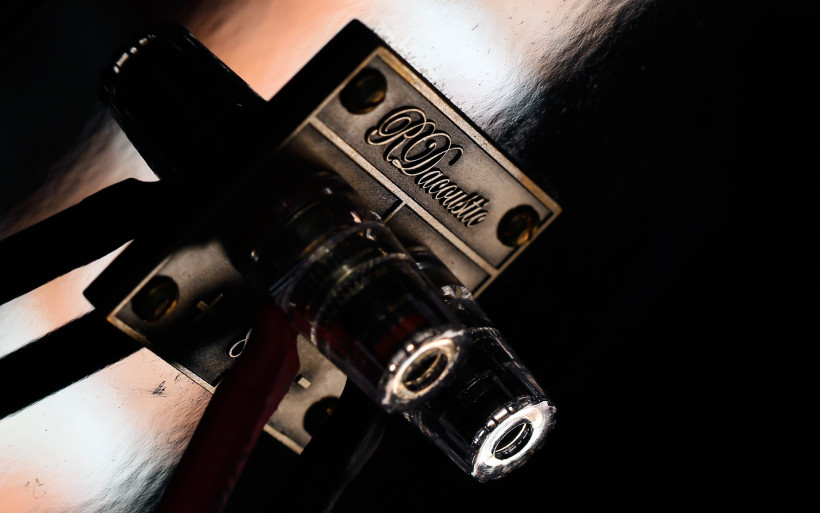 In order to make sure that Evolution case won’t happen, proper mail with concerns was sent and Martin replied quickly. I was convinced that he’ll share my point of view. But before we go any deeper into this material, rest assured that this man knows how to talk to press and presumably to clients as well. Some people simply are aware of how important this is. Martin’s responses were always kind and delivered in a jiffy. That second part is – dare I say – a rarity. Many manufacturers should learn from our man about fine arts of human interaction and PR. No bullshit policy is another plus. RDacoustic guys aren’t full of themselves, no “we make the best speakers in the world!” declarations anywhere in sight. When one adds modesty, lots of technicals without any kind of evasiveness, being upfront, fast response time and snake oil free attitude, journalist’s handshake and kindness is what one gets in return. Moving on, Martin solved all my problems like it was nothing, with one short mail: “No worries about the room, Evolution will fit in there. We’ll deliver the goods ourselves”. There’s only one response to this kind of dedication: “Let’s proceed then, shall we?”. And as promised, they did.
In order to make sure that Evolution case won’t happen, proper mail with concerns was sent and Martin replied quickly. I was convinced that he’ll share my point of view. But before we go any deeper into this material, rest assured that this man knows how to talk to press and presumably to clients as well. Some people simply are aware of how important this is. Martin’s responses were always kind and delivered in a jiffy. That second part is – dare I say – a rarity. Many manufacturers should learn from our man about fine arts of human interaction and PR. No bullshit policy is another plus. RDacoustic guys aren’t full of themselves, no “we make the best speakers in the world!” declarations anywhere in sight. When one adds modesty, lots of technicals without any kind of evasiveness, being upfront, fast response time and snake oil free attitude, journalist’s handshake and kindness is what one gets in return. Moving on, Martin solved all my problems like it was nothing, with one short mail: “No worries about the room, Evolution will fit in there. We’ll deliver the goods ourselves”. There’s only one response to this kind of dedication: “Let’s proceed then, shall we?”. And as promised, they did.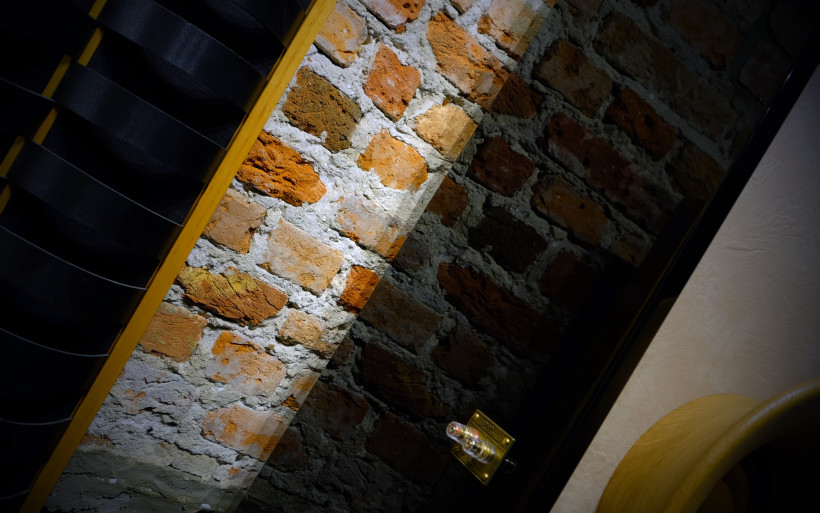 Martin arrived with Radovan in a car full of Czech goodies. All by themselves, both gents carried Evolution floorstanders all the way to their destined place. While my guests handled big and heavy packages, I was allowed to watch and nothing past that, therefore my back says big “thank you”. Once both speakers were set, a pair of Oris 500 horns and separate Fostex widebanders were provided. That no bullshit part mentioned above? The three of us spent several hours together, mostly talking. That’s long enough to know who’s who. And while we’re at it, RD is a handy shortcut for Radovan Řehořek and David Piska. The former gent is RDacoustic’s main man, the latter is responsible for casework and other things and, among other activities, Martin handles customers and press. Dandy.
Martin arrived with Radovan in a car full of Czech goodies. All by themselves, both gents carried Evolution floorstanders all the way to their destined place. While my guests handled big and heavy packages, I was allowed to watch and nothing past that, therefore my back says big “thank you”. Once both speakers were set, a pair of Oris 500 horns and separate Fostex widebanders were provided. That no bullshit part mentioned above? The three of us spent several hours together, mostly talking. That’s long enough to know who’s who. And while we’re at it, RD is a handy shortcut for Radovan Řehořek and David Piska. The former gent is RDacoustic’s main man, the latter is responsible for casework and other things and, among other activities, Martin handles customers and press. Dandy.
Build
RDacoustic Evolution is the only product in Czech manufacture’s portfolio. Since it’s expensive and big, the assumption of something more affordable and smaller in said company’s skunkworks is probably right. But at the same time please acknowledge that this is just a guessing game and not an announcement. In any case, RDacoustic decided to kick it off with flagship type of a product. Evolution looks, feels and costs like one, that’s a given. Delivered floorstanders are exceptionally big, each weighs hefty 75 kilograms and measures (H x W x D) 180 x 45 x 50 cm. Heck, upon request manufacturer can fancy a 40 cm taller and bassier version. But let’s focus on classic Evolution product. Why in these visually modern and minimalistic times one would like to possess coffins this big? To hide bodies inside? Dirty money? Forbidden firepower? Pets maybe? Or him/herself as a part of some kinky domestic BDSM game? Said floorstanders’ looks indicate that something along those lines might be factually correct, but rest assured that the truth lies elsewhere. Each box sports only one full-range speaker, which is rear-horn loaded with a huge transmission line hid inside a very fancy and somewhat phallic alike enclosure. In order to get decent bass response without additional drivers, said venting has to be of this very sort. It starts right behind transducer’s rear, constantly expands from this point onwards and visible mouth in lower cabinet’s part is where it ends. The enclosure’s top and bottom roundings are necessary, these preventive measures tame standing waves.
Delivered floorstanders are exceptionally big, each weighs hefty 75 kilograms and measures (H x W x D) 180 x 45 x 50 cm. Heck, upon request manufacturer can fancy a 40 cm taller and bassier version. But let’s focus on classic Evolution product. Why in these visually modern and minimalistic times one would like to possess coffins this big? To hide bodies inside? Dirty money? Forbidden firepower? Pets maybe? Or him/herself as a part of some kinky domestic BDSM game? Said floorstanders’ looks indicate that something along those lines might be factually correct, but rest assured that the truth lies elsewhere. Each box sports only one full-range speaker, which is rear-horn loaded with a huge transmission line hid inside a very fancy and somewhat phallic alike enclosure. In order to get decent bass response without additional drivers, said venting has to be of this very sort. It starts right behind transducer’s rear, constantly expands from this point onwards and visible mouth in lower cabinet’s part is where it ends. The enclosure’s top and bottom roundings are necessary, these preventive measures tame standing waves. Big chassis loaded with just one fairly small widebander isn’t anything new in our hobby. This concept is rather simple, very minimalistic in fact, but the devil is in the detail. Evolution model consists of several elements only; an enclosure, a transducer, speaker terminals and rather short internal wiring. Each of these elements impact the outcome and the real task is to make ’em all play along nicely.
Big chassis loaded with just one fairly small widebander isn’t anything new in our hobby. This concept is rather simple, very minimalistic in fact, but the devil is in the detail. Evolution model consists of several elements only; an enclosure, a transducer, speaker terminals and rather short internal wiring. Each of these elements impact the outcome and the real task is to make ’em all play along nicely.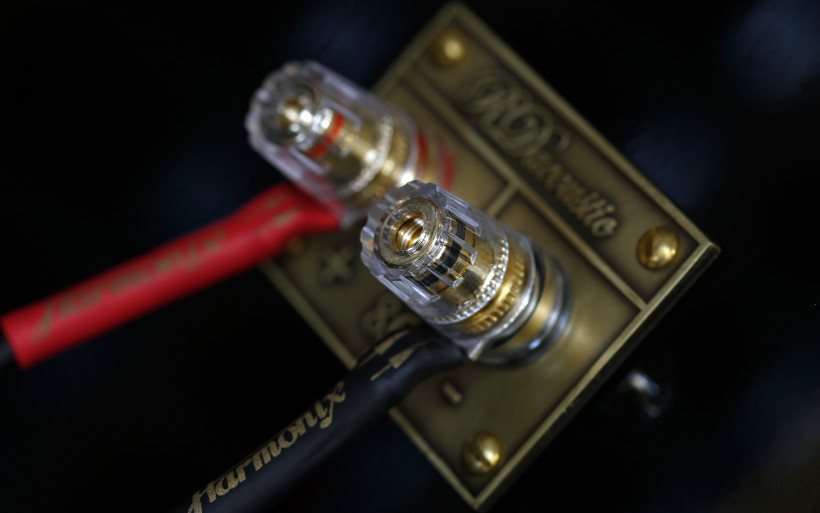 Evolution’s cabinet is made out of 2,5 cm thick, yet unusually dense and stiff type of MDF. It has to be as driver change at users end is possible. That’s one of said product’s key features, we’ll get back to that in a bit. Martin informed me that the final version took several years of work and about 20 iterations to get it right. Its specific shape isn’t random, on the contrary. Every bend, curve and angle is very important, proper and very precise geometry is crucial. To give a perfect example, short look at Evolution’s front shows slight sidewalls’ tilt from bottom to top. The exact number is one degree. Just one, that’s all it takes to get rid of some of unwanted resonances according to Radovan. Not to mention that because of said measure, Evolution looks a bit slimmer, its quite fit figure is the visible outcome.
Evolution’s cabinet is made out of 2,5 cm thick, yet unusually dense and stiff type of MDF. It has to be as driver change at users end is possible. That’s one of said product’s key features, we’ll get back to that in a bit. Martin informed me that the final version took several years of work and about 20 iterations to get it right. Its specific shape isn’t random, on the contrary. Every bend, curve and angle is very important, proper and very precise geometry is crucial. To give a perfect example, short look at Evolution’s front shows slight sidewalls’ tilt from bottom to top. The exact number is one degree. Just one, that’s all it takes to get rid of some of unwanted resonances according to Radovan. Not to mention that because of said measure, Evolution looks a bit slimmer, its quite fit figure is the visible outcome. RDacoustic Evolution is exceptionally well-made. The assembly is meticulous, no glue marks anywhere in sight, which leads to not a DIY but very professional work done. Add a leatherette on products’ front and back, a bit glittery paint job and there you have it, visual luxury in its full glory. Available finishes’ list is more than extensive, one can pick to his/hers heart’s content in that regard. When product this big can be ordered to match living room’s furniture, it might be a decisive factor for some aesthetic-heavy individuals.
RDacoustic Evolution is exceptionally well-made. The assembly is meticulous, no glue marks anywhere in sight, which leads to not a DIY but very professional work done. Add a leatherette on products’ front and back, a bit glittery paint job and there you have it, visual luxury in its full glory. Available finishes’ list is more than extensive, one can pick to his/hers heart’s content in that regard. When product this big can be ordered to match living room’s furniture, it might be a decisive factor for some aesthetic-heavy individuals.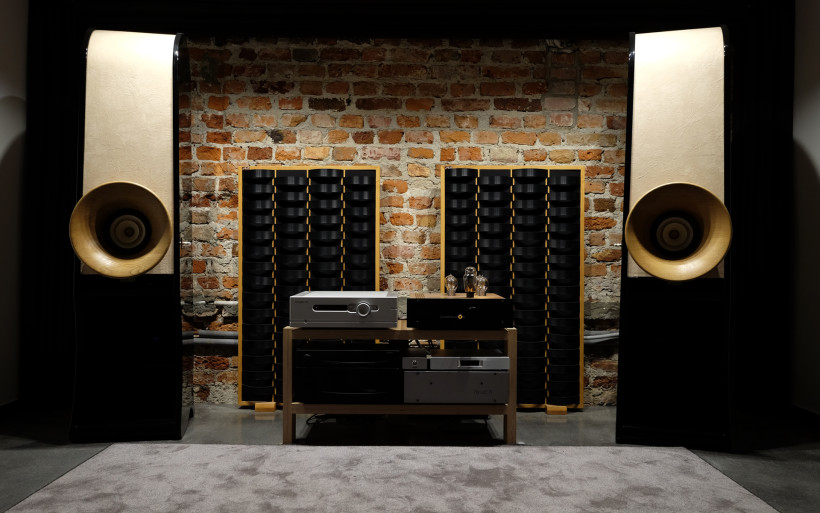 Since RDacoustic Evolution is based on only one widebander per cabinet, there’s no need for filtration, hence no crossover is present in our Czech case. But the real fun begins with available drivers. Fostex FE 206en transducer comes in as a standard and most affordable option. Moving upwards, Lowther and Voxativ products are available and I was provided with the latter’s AC-1.8 model, which transforms delivered product into the most expensive version available. All of aforementioned widebanders are of high efficiency, hence 300B SET amplifiers are considered as a very good match for Evolution type of products. But the best part is that one can easily install a new transducer very quickly. The procedure is as follows: unmount a black ring around a driver, then handle four screws in total, connect two cables to a new speaker, mount it where it belongs, cover screws with aforementioned ring and… that’s it. Five to ten minutes of your time is all it takes to get it done. Well, transducers are quite fragile and weighty, therefore caution is advised. But to roll drivers instead of new floorstanders’ purchase is a fantastic idea from buyer’s perspective.
Since RDacoustic Evolution is based on only one widebander per cabinet, there’s no need for filtration, hence no crossover is present in our Czech case. But the real fun begins with available drivers. Fostex FE 206en transducer comes in as a standard and most affordable option. Moving upwards, Lowther and Voxativ products are available and I was provided with the latter’s AC-1.8 model, which transforms delivered product into the most expensive version available. All of aforementioned widebanders are of high efficiency, hence 300B SET amplifiers are considered as a very good match for Evolution type of products. But the best part is that one can easily install a new transducer very quickly. The procedure is as follows: unmount a black ring around a driver, then handle four screws in total, connect two cables to a new speaker, mount it where it belongs, cover screws with aforementioned ring and… that’s it. Five to ten minutes of your time is all it takes to get it done. Well, transducers are quite fragile and weighty, therefore caution is advised. But to roll drivers instead of new floorstanders’ purchase is a fantastic idea from buyer’s perspective. As a company, RDacoustic clearly is past DIY phase. Yet some things can be customized and upgraded. Speaker terminals mounted e.g. on product’s rear and not side is a perfect example, pick your poison accordingly. If a customer is after top shelf experience in this regard, gold-plated WBT upper echelon (€940/pr) is for the taking. So is granite base (€700/pr) and vast array of Fostex wooden tapers (€40/pr). These are meant to work with Fostex widebanders exclusively. However, the most significant upgrade available (drivers aside) seems to be oaken horn tubes, a.k.a. Oris 500 (€2’00/pr). These heavy, marvelously finished, 40 cm wide and 15 cm deep items replace stock MDF rings around mounted widebanders. Make no mistake here, said wooden additions change the sound significantly, please read below.
As a company, RDacoustic clearly is past DIY phase. Yet some things can be customized and upgraded. Speaker terminals mounted e.g. on product’s rear and not side is a perfect example, pick your poison accordingly. If a customer is after top shelf experience in this regard, gold-plated WBT upper echelon (€940/pr) is for the taking. So is granite base (€700/pr) and vast array of Fostex wooden tapers (€40/pr). These are meant to work with Fostex widebanders exclusively. However, the most significant upgrade available (drivers aside) seems to be oaken horn tubes, a.k.a. Oris 500 (€2’00/pr). These heavy, marvelously finished, 40 cm wide and 15 cm deep items replace stock MDF rings around mounted widebanders. Make no mistake here, said wooden additions change the sound significantly, please read below.
Sound
Equipment wise, this was an easy task as heavy-lifting was done by Srajan Ebaen already. Evolution is a high efficiency product, hence on a paper some things are off the table and some are a must. In order not to make this chapter too long, two out of three amplifiers were used. Sanders Sound Systems Magtech power amplifier and its preamplifier weren’t used, this combo is an overkill in our Czech case, that goes rather without saying. But Firstwatt F7 is something 6moons.com owner used and it worked for him rather well. Since this American marvel is a part of my setup, the decision to use it was a no-brainer. Third option – Trilogy 925 integrated – also fits. To a point it operates in class A and it sounds terrific. And what about 300B SET owners? Not this scribe’s thing, apologies. In any case, LampizatOr Golden Gate made it all click, as per usual. To make the picture complete, Boenicke W8 were used too. Ah, Oris 500 and driver swaps were done somewhere along the road. Until it says otherwise, all tests were conducted with Evolution loaded with pricey wooden “ears” and Voxativ AC-1.8 drivers.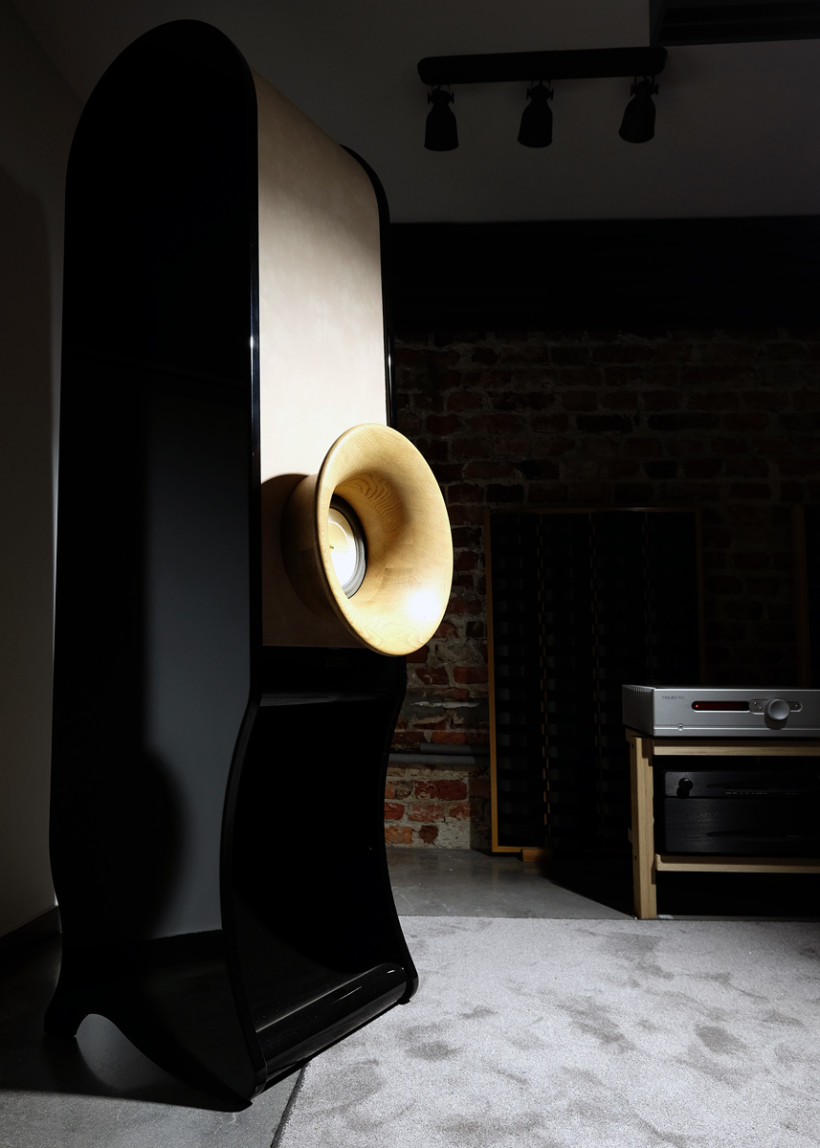 The very first thing on a ‘to do’ list was to establish which amplifier Evolution speakers fancy more, whether it’s English Trilogy 925 or American Firstwatt F7. The latter came in as first and the outcome was familiar. Pleasant warmth and fair amount of density were to be expected. Lots of information served on top of that made our already sweet piece of pie even tastier. These aspects aside, Firstwatt F7 sounded very smooth, which Voxativ AC-1.8 drivers showed without breaking a sweat. No cable swaps had to be done to achieve that and American + Polish + Czech combination was a job well-done, that was the outcome. This kind of an easygoing experience is something to behold. When one simply enjoys it to a degree when it’s rather difficult to switch to a precise evaluation mode… that’s perfectly fine and desirable scenario. It simply gets one deeply involved and isn’t it the gist of this hobby?
The very first thing on a ‘to do’ list was to establish which amplifier Evolution speakers fancy more, whether it’s English Trilogy 925 or American Firstwatt F7. The latter came in as first and the outcome was familiar. Pleasant warmth and fair amount of density were to be expected. Lots of information served on top of that made our already sweet piece of pie even tastier. These aspects aside, Firstwatt F7 sounded very smooth, which Voxativ AC-1.8 drivers showed without breaking a sweat. No cable swaps had to be done to achieve that and American + Polish + Czech combination was a job well-done, that was the outcome. This kind of an easygoing experience is something to behold. When one simply enjoys it to a degree when it’s rather difficult to switch to a precise evaluation mode… that’s perfectly fine and desirable scenario. It simply gets one deeply involved and isn’t it the gist of this hobby?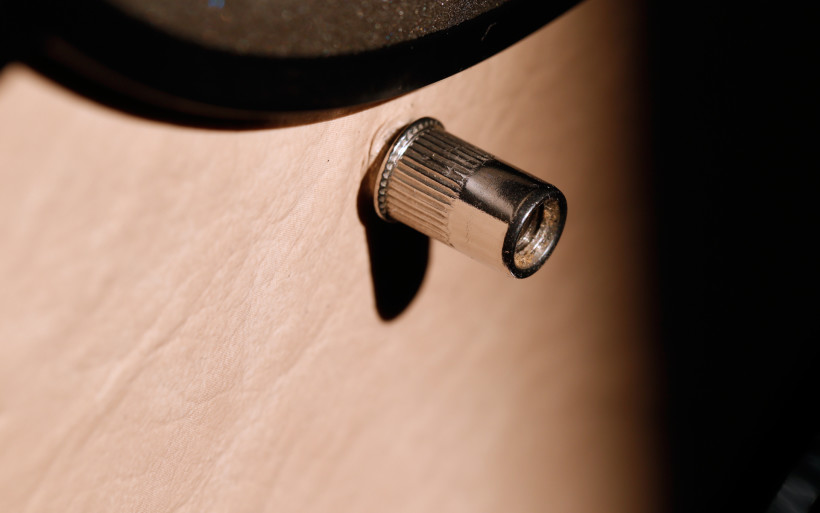 There was only one way to find out if it gets any better within somewhat limited resources on hand, Nelson’s lucky number seven swapped places with English 925 integrated. Srajan wrote in his article that some high efficiency widebanders actually benefit from higher wattages. To my very ears that’s the case with Evolution and F7 versus 925. Some things are taken, yet some are added in return and the real question is whether one can live with this. Not one, but many aspects have changed in the process. With English integrated in the chain, the sound became denser and bigger. It could be easily heard that additional muscle tissue appeared, especially in downstairs department. The bass got thicker, yes, but not without audible trade-off. The outcome was a bit stiffer. Just slightly, yet noticeably. The instruments’ edges were more defined in very accurate space, yet smoothness remained untouched. The soundstage got wider and the very first row of instruments was served closer, hence the bigger, yet as detailed and multi-layered picture as with Firstwatt F7. It was hard to shake off the feeling that the latter sounded smaller, yet mellower, more romantic and emotional, with listener’s focus shifted to what’s between the speakers, whereas 925 represented more direct, closer and denser approach. The bottom line is that Nic Poulson’s state of the art integrated, paired with Evolution floorstanders turned out to be a joy provider and not an overkill. In fully balanced operation mode, pleasant 80 dB SPL was achieved with -49 dB attenuation on a 63 dB scale. Plenty of it was what’s left. Nelson’s single-ended F7 needed -17 dB on Golden Gate’s TAIV VC-03 module, which happens to operate in the same spectrum. In the end, Trilogy 925 was my subjective pick from this point onwards. Yet rest assured that both amplifiers handled Evolution in a marvelous fashion.
There was only one way to find out if it gets any better within somewhat limited resources on hand, Nelson’s lucky number seven swapped places with English 925 integrated. Srajan wrote in his article that some high efficiency widebanders actually benefit from higher wattages. To my very ears that’s the case with Evolution and F7 versus 925. Some things are taken, yet some are added in return and the real question is whether one can live with this. Not one, but many aspects have changed in the process. With English integrated in the chain, the sound became denser and bigger. It could be easily heard that additional muscle tissue appeared, especially in downstairs department. The bass got thicker, yes, but not without audible trade-off. The outcome was a bit stiffer. Just slightly, yet noticeably. The instruments’ edges were more defined in very accurate space, yet smoothness remained untouched. The soundstage got wider and the very first row of instruments was served closer, hence the bigger, yet as detailed and multi-layered picture as with Firstwatt F7. It was hard to shake off the feeling that the latter sounded smaller, yet mellower, more romantic and emotional, with listener’s focus shifted to what’s between the speakers, whereas 925 represented more direct, closer and denser approach. The bottom line is that Nic Poulson’s state of the art integrated, paired with Evolution floorstanders turned out to be a joy provider and not an overkill. In fully balanced operation mode, pleasant 80 dB SPL was achieved with -49 dB attenuation on a 63 dB scale. Plenty of it was what’s left. Nelson’s single-ended F7 needed -17 dB on Golden Gate’s TAIV VC-03 module, which happens to operate in the same spectrum. In the end, Trilogy 925 was my subjective pick from this point onwards. Yet rest assured that both amplifiers handled Evolution in a marvelous fashion.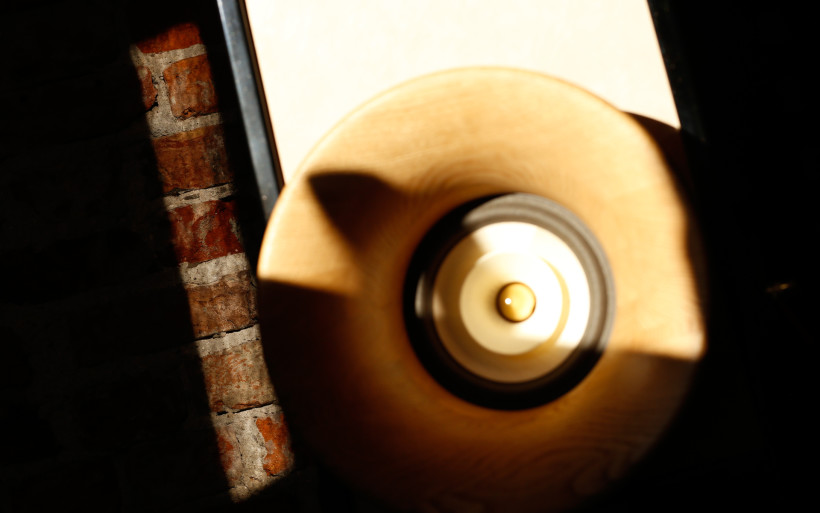 Past amplifier changes it was high time to address Oris 500 matter. This rather expensive, yet very finely crafted addition changes a lot of things indeed. It makes the outcome audibly denser, at least in a room like mine. Since Evolution isn’t an overly muscular performer on its own, far from it in fact, many potential customers will take some measures to make it gutsier. Class A amplification and particular cables are two out of several to achieve said goal. Consider Oris 500 as another one, low end extension and tonal balance shift lowered are things it does to Evolution’s sound. In most scenarios it’ll be a mandatory purchase then. The soundstage also gets deeper and i.e. distance to vocalists is increased. Also, the overall clarity is tweaked down. Without woody horns, Czech speakers perform in more clear, direct and effortless fashion, wider soundstage is also a part of the package. Wooden ears tend to focus listener’s attention on what’s between the speakers, whereas stock rings create more even, clear and open image. It is factually correct that it’s slightly less blurry. Oris 500 option reminded me about how Swiss W8 floorstanders behave with their woofers firing inside and out. The former option makes the outcome more romantic, denser and suave, whereas the latter presents the sound in wider, punchier and stiffer fashion. Swiss and Czech cases vary, but the takeaway is that one has to experiment to find personal sweet spot. Subjectively, would I go after Oris 500? You betcha. Just for the sake of having two different flavors on demand. The asking for a pair is steep, but fully justified.
Past amplifier changes it was high time to address Oris 500 matter. This rather expensive, yet very finely crafted addition changes a lot of things indeed. It makes the outcome audibly denser, at least in a room like mine. Since Evolution isn’t an overly muscular performer on its own, far from it in fact, many potential customers will take some measures to make it gutsier. Class A amplification and particular cables are two out of several to achieve said goal. Consider Oris 500 as another one, low end extension and tonal balance shift lowered are things it does to Evolution’s sound. In most scenarios it’ll be a mandatory purchase then. The soundstage also gets deeper and i.e. distance to vocalists is increased. Also, the overall clarity is tweaked down. Without woody horns, Czech speakers perform in more clear, direct and effortless fashion, wider soundstage is also a part of the package. Wooden ears tend to focus listener’s attention on what’s between the speakers, whereas stock rings create more even, clear and open image. It is factually correct that it’s slightly less blurry. Oris 500 option reminded me about how Swiss W8 floorstanders behave with their woofers firing inside and out. The former option makes the outcome more romantic, denser and suave, whereas the latter presents the sound in wider, punchier and stiffer fashion. Swiss and Czech cases vary, but the takeaway is that one has to experiment to find personal sweet spot. Subjectively, would I go after Oris 500? You betcha. Just for the sake of having two different flavors on demand. The asking for a pair is steep, but fully justified.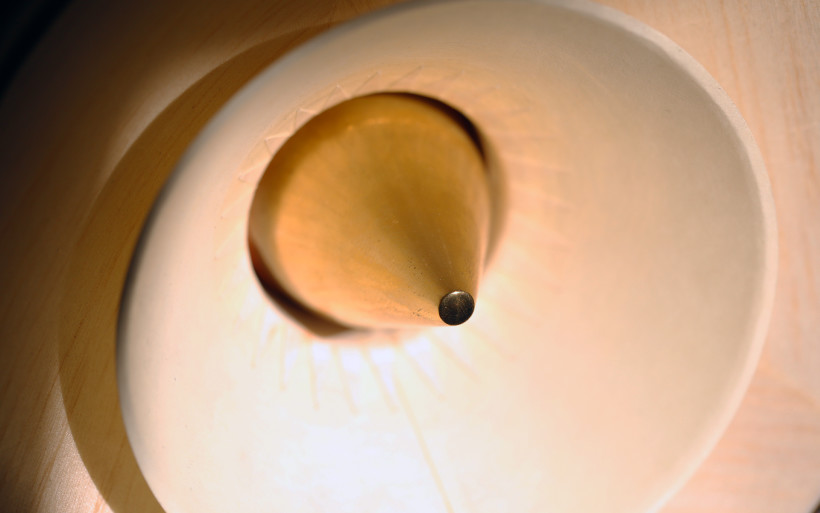 Once the most suitable Evolution company was picked, it was time to compare this product to my Boenicke W8. Since Trilogy 925 integrated was used with both models, it was highly convenient. As for the speakers, the latter looks tiny in a rather intimidating Czech presence, but in terms of sound this is very misleading. We’ll get to that part in a minute. Now one thing needs to be said right away, two completely different presentations is what we’re dealing with here. Swiss performers are gutsier and that’s something one hears in an instant. W8’s bass reaches lower, is similarly round and packs more punch, its downstairs presence is simply felt more. Sven’s smallest floorstanders also sound a bit darker in comparison to Evolution, even once the latter is loaded with Oris 500. This doesn’t mean that one model is plainly dark or the other plays purely in lightweight league, subjectively nothing of this sort happens. Things aren’t that extreme in both cases, though aforementioned differences are there. Evolution simply sounds more ethereal, or airy if you will and when this kind of a performance is combined with inherent openness and effortlessness, things become exceptionally easygoing. W8 speakers also deliver different image presentation. The sound these make is plainly big, soundstage in front of a listener is always shown on the whole wall behind the product, the way W8 model evaporates from a room is amazing. Evolution handles the same task differently.
Once the most suitable Evolution company was picked, it was time to compare this product to my Boenicke W8. Since Trilogy 925 integrated was used with both models, it was highly convenient. As for the speakers, the latter looks tiny in a rather intimidating Czech presence, but in terms of sound this is very misleading. We’ll get to that part in a minute. Now one thing needs to be said right away, two completely different presentations is what we’re dealing with here. Swiss performers are gutsier and that’s something one hears in an instant. W8’s bass reaches lower, is similarly round and packs more punch, its downstairs presence is simply felt more. Sven’s smallest floorstanders also sound a bit darker in comparison to Evolution, even once the latter is loaded with Oris 500. This doesn’t mean that one model is plainly dark or the other plays purely in lightweight league, subjectively nothing of this sort happens. Things aren’t that extreme in both cases, though aforementioned differences are there. Evolution simply sounds more ethereal, or airy if you will and when this kind of a performance is combined with inherent openness and effortlessness, things become exceptionally easygoing. W8 speakers also deliver different image presentation. The sound these make is plainly big, soundstage in front of a listener is always shown on the whole wall behind the product, the way W8 model evaporates from a room is amazing. Evolution handles the same task differently. We’ve already established that the outcome depends on Oris 500 usage in our Czech case. Yet within my own four walls, these floorstanders’ sound isn’t as tall or wide as its Swiss competitor’s. It’s fair to say that W8 sings in a more spectacular, even somewhat showy or intimidating way and once this model’s narrow and short frame is added to the mix, the so-called wow factor is clearly there. However, Evolution delivers a very coherent, big and accurate imaging too. Past W8 switch, one is quickly drawn into Czech order of things and somewhat smaller picture isn’t painful at all. On top of that, this product has remarkable midrange, it’s very smooth and vivid. The very same thing can be said about W8 in that regard. But Evolution dishes out additional air around vocals and makes these a bit stiffer on the edges, more pronounced and posh in the end. With wooden ears on, the outcome is quite horn-alike, which for many enthusiasts is something to die for. Yet without said physical addition, that midrange magic isn’t there. The takeaway is that both compared models are sophisticated, though greatly different flavour providers, which was perfectly expected from the get-go. During several weeks time, both were used in more or less equal ratio, which is unusual. Once introductory phase is in the past, one favourite product tends to be used more, but not this time. Yours truly simply enjoyed the same dish served by two different chefs.
We’ve already established that the outcome depends on Oris 500 usage in our Czech case. Yet within my own four walls, these floorstanders’ sound isn’t as tall or wide as its Swiss competitor’s. It’s fair to say that W8 sings in a more spectacular, even somewhat showy or intimidating way and once this model’s narrow and short frame is added to the mix, the so-called wow factor is clearly there. However, Evolution delivers a very coherent, big and accurate imaging too. Past W8 switch, one is quickly drawn into Czech order of things and somewhat smaller picture isn’t painful at all. On top of that, this product has remarkable midrange, it’s very smooth and vivid. The very same thing can be said about W8 in that regard. But Evolution dishes out additional air around vocals and makes these a bit stiffer on the edges, more pronounced and posh in the end. With wooden ears on, the outcome is quite horn-alike, which for many enthusiasts is something to die for. Yet without said physical addition, that midrange magic isn’t there. The takeaway is that both compared models are sophisticated, though greatly different flavour providers, which was perfectly expected from the get-go. During several weeks time, both were used in more or less equal ratio, which is unusual. Once introductory phase is in the past, one favourite product tends to be used more, but not this time. Yours truly simply enjoyed the same dish served by two different chefs.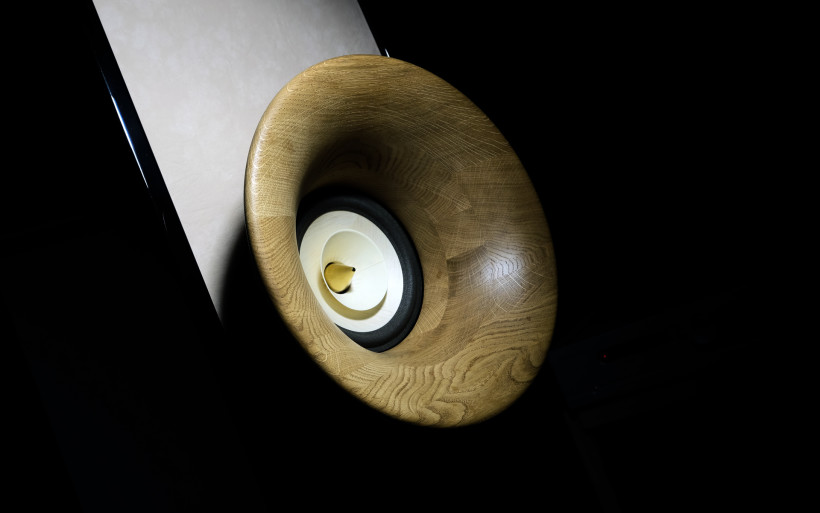 Before we’ll go any further, a word about room placement and used drivers is in order. At first, Evolution speakers were placed in the corners, just to see what will happen. The outcome was decent, proper figures were ‘seen’ in the virtual space and it could stay that way. Yet additional tryouts were needed as mighty Czech coffins were ‘visible’ still. When this happens with point source full-range drivers, one knows that additional experiments have to be conducted. Evolution boxes were shifted from rear and side surfaces by about 70 and 80 cm respectively, which gave them additional room to breathe. Both drivers’ axes crossed a bit behind my noggin, whereas the distance to speakers was 3,5 meters long. Said measures led to instruments additionally fleshed out and placed in even bigger space. All that happened with no trade-offs. Both drivers presence could be more or less singled out at rare occasions, but who knows? Perhaps in even bigger room reviewed product would have vanished completely? That’s of no importance now, it is what it is.
Before we’ll go any further, a word about room placement and used drivers is in order. At first, Evolution speakers were placed in the corners, just to see what will happen. The outcome was decent, proper figures were ‘seen’ in the virtual space and it could stay that way. Yet additional tryouts were needed as mighty Czech coffins were ‘visible’ still. When this happens with point source full-range drivers, one knows that additional experiments have to be conducted. Evolution boxes were shifted from rear and side surfaces by about 70 and 80 cm respectively, which gave them additional room to breathe. Both drivers’ axes crossed a bit behind my noggin, whereas the distance to speakers was 3,5 meters long. Said measures led to instruments additionally fleshed out and placed in even bigger space. All that happened with no trade-offs. Both drivers presence could be more or less singled out at rare occasions, but who knows? Perhaps in even bigger room reviewed product would have vanished completely? That’s of no importance now, it is what it is.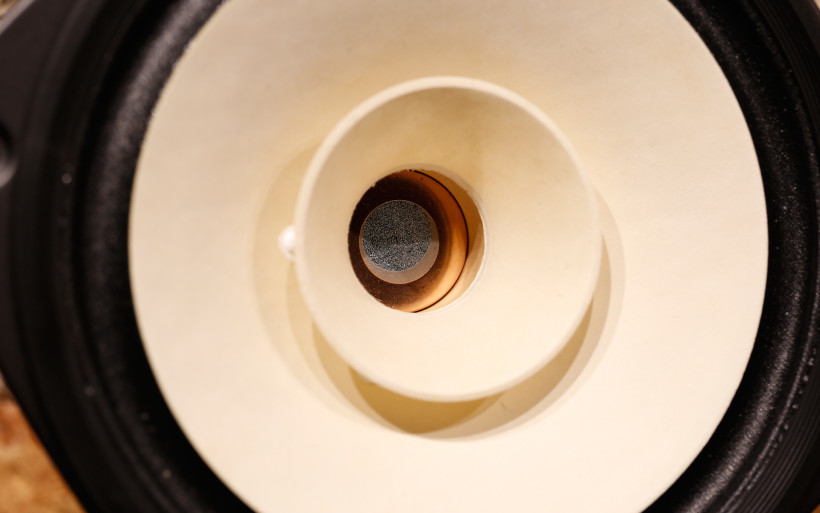 What matters is that the outcome was impressive, much better than expected. As for drivers, this tale will be short. After Martin and Radovan arrival and past setup phase, we kicked it off with Voxativs, but Fostex swap was done shortly after. Czech engineer wanted to present the ease of said procedure. Voxativ’s mellowness was gone in an instant, feistiness appeared instead and treble became less present. Additionally, low end scored some downstairs extension points, images became sharper and the outcome was more raw. After a rather long while I’ve said: “OK, I’m fully aware of what’s what, now can we get back to German widebanders please?”. Radovan nodded his head, smiled and performed the deed. Maybe with 300B SET amplifier things would’ve been different, honestly I can’t say. But what I do know is that during several weeks time span, both drivers’ sets were rolled two times. And I’m confident to say that Voxativ’s are subjectively more pleasant to listen to, that’s this paragraph’s takeaway.
What matters is that the outcome was impressive, much better than expected. As for drivers, this tale will be short. After Martin and Radovan arrival and past setup phase, we kicked it off with Voxativs, but Fostex swap was done shortly after. Czech engineer wanted to present the ease of said procedure. Voxativ’s mellowness was gone in an instant, feistiness appeared instead and treble became less present. Additionally, low end scored some downstairs extension points, images became sharper and the outcome was more raw. After a rather long while I’ve said: “OK, I’m fully aware of what’s what, now can we get back to German widebanders please?”. Radovan nodded his head, smiled and performed the deed. Maybe with 300B SET amplifier things would’ve been different, honestly I can’t say. But what I do know is that during several weeks time span, both drivers’ sets were rolled two times. And I’m confident to say that Voxativ’s are subjectively more pleasant to listen to, that’s this paragraph’s takeaway.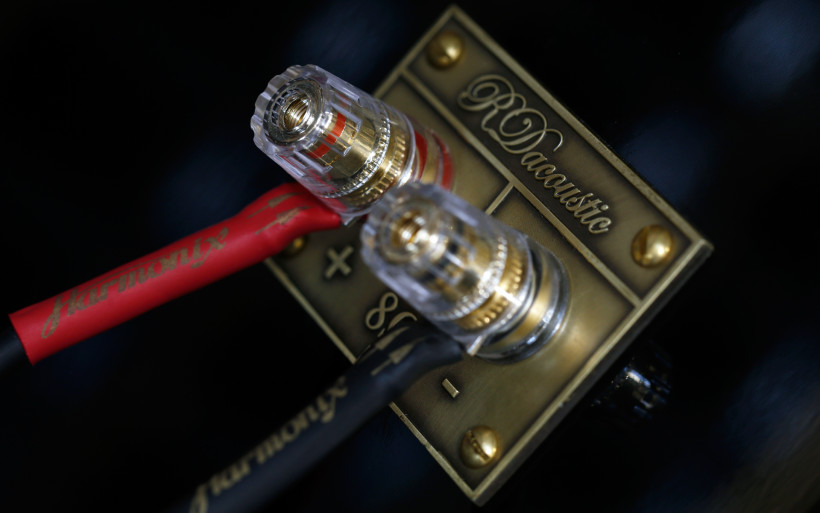 After all experiments and comparisons above, the clear picture of what Evolution is capable of emerged. Said speakers’ sound is unique on many levels. First of all, with Oris 500 and Voxativ drivers, its bottom edge is neatly trimmed. Don’t expect bass that reaches to the lowest depths of hell, it serves as an additive feature of quality and not quantity. In small space like mine and after many hours of listening, I’m confident to say that FR range shorter than usual isn’t an issue at all. On the contrary in fact, Evolution’s bass is well-differentiated, controlled, textured and – above all else – present. To have it even lower would be a nice feature, but this is a wishful thinking and nothing past that. In the long run, the bass gets along perfectly fine with what’s above and it reaches deep enough to be pleasant and not thin or hollow. The longer Evolution experience lasted, the more convinced yours truly was that that’s the case.
After all experiments and comparisons above, the clear picture of what Evolution is capable of emerged. Said speakers’ sound is unique on many levels. First of all, with Oris 500 and Voxativ drivers, its bottom edge is neatly trimmed. Don’t expect bass that reaches to the lowest depths of hell, it serves as an additive feature of quality and not quantity. In small space like mine and after many hours of listening, I’m confident to say that FR range shorter than usual isn’t an issue at all. On the contrary in fact, Evolution’s bass is well-differentiated, controlled, textured and – above all else – present. To have it even lower would be a nice feature, but this is a wishful thinking and nothing past that. In the long run, the bass gets along perfectly fine with what’s above and it reaches deep enough to be pleasant and not thin or hollow. The longer Evolution experience lasted, the more convinced yours truly was that that’s the case. Voxativ AC-1.8 drivers sound very smooth and mainly because of that, Czech speakers’ highs are a real pleasure to listen to. Treble is served in a mellow and delicate, yet not overly thin fashion. It acts like a fine spice to a very singular dish, which wouldn’t be this tasty without it. Yet it is the midrange, around which the whole Evolution world revolves and this journalist’s focus was usually there. It’s full, nicely saturated and generously detailed. With certain types of music, i.e. jazz, this model does things my own W8 speakers don’t. To give a perfect example, David Brubeck’s “Take Five” sounded admirably big on Evolution, with all the band literally in front of me. This was a real eye-opener. All the instruments were sketched precisely, yet not clinical at all, and had a very vivid appearance in a remarkably convincing, big and open soundstage. Sven’s smallest floorstanders kept up the pace in some regards, namely imaging and its depth. But in terms of overall realism, involvement and tear-jerking capabilities, with this type of repertoire Evolution is a subjective winner.
Voxativ AC-1.8 drivers sound very smooth and mainly because of that, Czech speakers’ highs are a real pleasure to listen to. Treble is served in a mellow and delicate, yet not overly thin fashion. It acts like a fine spice to a very singular dish, which wouldn’t be this tasty without it. Yet it is the midrange, around which the whole Evolution world revolves and this journalist’s focus was usually there. It’s full, nicely saturated and generously detailed. With certain types of music, i.e. jazz, this model does things my own W8 speakers don’t. To give a perfect example, David Brubeck’s “Take Five” sounded admirably big on Evolution, with all the band literally in front of me. This was a real eye-opener. All the instruments were sketched precisely, yet not clinical at all, and had a very vivid appearance in a remarkably convincing, big and open soundstage. Sven’s smallest floorstanders kept up the pace in some regards, namely imaging and its depth. But in terms of overall realism, involvement and tear-jerking capabilities, with this type of repertoire Evolution is a subjective winner.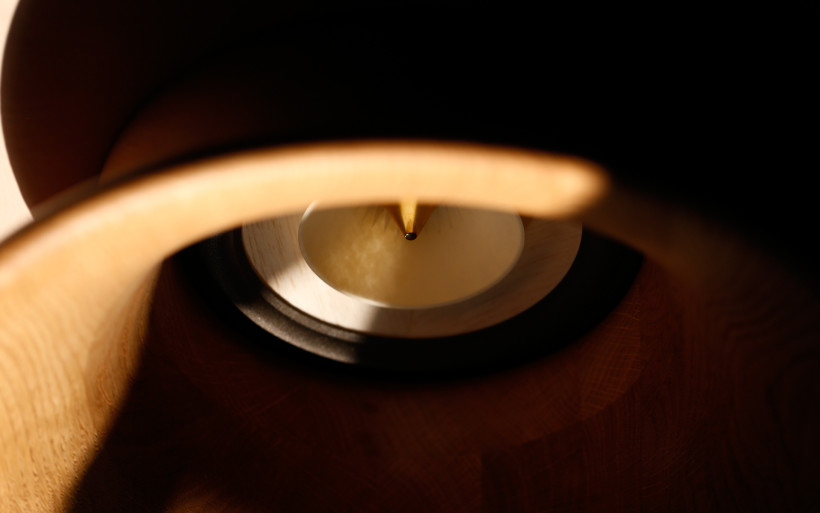 There’s a big number of tracks which W8 model does subjectively better, namely various heavy rock music, or grand scale drums a.k.a. Kodo and alike. To be perfectly honest, the latter genre can be covered realistically only by big and very well-controlled drivers. Czech product isn’t meant to be used with such examples and this goes rather without saying. Some clear boundaries of what it can do right obviously exist. Yet the way how Evolution handles Eivør Pálsdóttir, Wardruna or Bat for Lashes and alike, is simply admirable. Heck, even Tito & Tarantula’s “After Dark” was impressive. And the more funky material was delivered, the more capable Evolution turned out to be. For instance, Polish indie artist Dawid Podsiadło or American experimental rock Battles sounded very good. Midrange richness and very open character really can make one to smile widely. At the same time things can get properly sad and very intense, Einsturzende Neubauten’s “Nagorny Karabach” is remarkable at that, the same story is with this group’s “Sabrina”. The point is that Evolution shows emotional features like champ. Just to see how far it can go in that regard, Julee Curtis “Floating into the Night” was used. Once this record appeared on my playback list, it stayed there for weeks. Its dreamy and longing character is plainly addictive, and that’s what Czech product emphasized perfectly.
There’s a big number of tracks which W8 model does subjectively better, namely various heavy rock music, or grand scale drums a.k.a. Kodo and alike. To be perfectly honest, the latter genre can be covered realistically only by big and very well-controlled drivers. Czech product isn’t meant to be used with such examples and this goes rather without saying. Some clear boundaries of what it can do right obviously exist. Yet the way how Evolution handles Eivør Pálsdóttir, Wardruna or Bat for Lashes and alike, is simply admirable. Heck, even Tito & Tarantula’s “After Dark” was impressive. And the more funky material was delivered, the more capable Evolution turned out to be. For instance, Polish indie artist Dawid Podsiadło or American experimental rock Battles sounded very good. Midrange richness and very open character really can make one to smile widely. At the same time things can get properly sad and very intense, Einsturzende Neubauten’s “Nagorny Karabach” is remarkable at that, the same story is with this group’s “Sabrina”. The point is that Evolution shows emotional features like champ. Just to see how far it can go in that regard, Julee Curtis “Floating into the Night” was used. Once this record appeared on my playback list, it stayed there for weeks. Its dreamy and longing character is plainly addictive, and that’s what Czech product emphasized perfectly.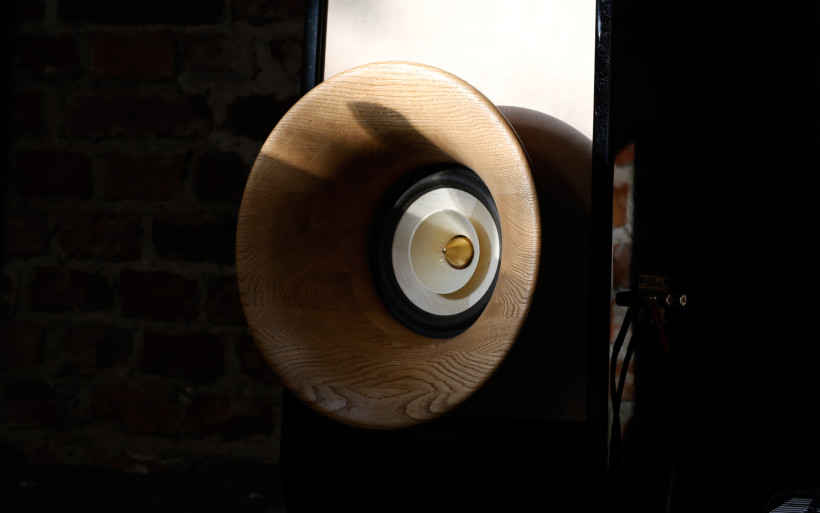 Although Evolution paints smaller picture in comparison to W8 model, it’s still very big and served effortlessly. Swiss floorstanders are simply enormous in that regard in particular. Let me just add that because of its inherent features, our Czech champ will never scream at you or sing faster than necessary. It isn’t neither speed or detailing freak, nervous tension simply isn’t there. What it provides instead is mild and soothing experience, which is very likeable as is. When such aspects are combined with smooth, rich and courteous approach, the sound chains one to a listening chair for hours easily. To simply kick back and relax is the desirable outcome, ain’t it?
Although Evolution paints smaller picture in comparison to W8 model, it’s still very big and served effortlessly. Swiss floorstanders are simply enormous in that regard in particular. Let me just add that because of its inherent features, our Czech champ will never scream at you or sing faster than necessary. It isn’t neither speed or detailing freak, nervous tension simply isn’t there. What it provides instead is mild and soothing experience, which is very likeable as is. When such aspects are combined with smooth, rich and courteous approach, the sound chains one to a listening chair for hours easily. To simply kick back and relax is the desirable outcome, ain’t it?
Summary
Products of Evolution sort surely don’t come very often in a world full of typical, bass-reflex vented two- or threeways. Our singular Czech performer is tailor-made to handle certain types of music, yet it gets along just fine with repertoire said to be a misunderstanding with such product. But when it does, the sensation of something completely different is present in an instant. RDacoustic Evolution handles the sound in a very pleasing fashion and doesn’t look at competitors while doing so. Its main goal is to involve a listener, it doesn’t play in casual league, far from it in fact. This is a well-seasoned product, for someone who can appreciate this kind of a transmission line and widebander affair. An aficionado of this sort and in search of emotions served in an enjoyable, vivid, stress-free an open way, should be aware that Evolution ought to be auditioned, simple as that. What an unusual product.
Of course one has to swallow Evolution’s intimidating posture first, that goes rather without saying. Czech boxes are big and heavy attention grabbers. Charming, pleasant to look at, somewhat vintage, very finely made and cheers to all that. Yet at the same time their presence is felt constantly, this isn’t a product that will disappear after a while. No way, Jose. And the smaller space given, the more obvious and present said floorstanders become. This is neither a flaw, nor an advantage but an obvious fact. You be the judge whether you can handle it.
Evolution is extremely versatile build wise, almost to a DIY degree. The amount of finishes available is very generous. The ability to roll stock and horned rings accordingly to one’s environment/taste/mood is honestly admirable. These items bring a very audible difference, each has its own strengths and weaknesses, therefore getting familiarized with both is highly recommended. But the fact alone that manufacturer actually enable this kind of potent adjustments, encourages it even, and the same story is with speakers swaps, is nothing short but praiseworthy. Which company allows a change of calibre this heavy? Kudos. All things considered, Evolution as a name is fully justified and most suitable. Is reviewed product’s price as well?
RDacoustic Evolution’s asking is undoubtedly steep. For this kind of dough, lots of things can be done in our hobby. It’s a luxury item above all else, which sounds and looks like a huge pile of money. Yet it’s not set in stone that one has to start from the very top, namely Voxativ and Oris 500 loaded €16’990 product, let alone marble bases (€700/pr) and WBT gold-plated terminals (€940/pr). The most affordable Fostex vanilla option has €6’000 less on its price tag, which is a reasonable start. And if the notion of Evolution as a package turns out to be a bull’s-eye decision indeed, moving to upper echelon in the future is a breeze. To summarize, Czech floorstanders are worth taking into consideration if one is into this kind of an unusual, yet highly rewarding experience. Subjectively, I had a blast with these. ‘Till next time.
- Loudspeakers: Boenicke Audio W8
- Amplifiers: Trilogy 925, Firstwatt F7
- Digital source: Lampizator Golden Gate (WE101D-L + 5U4G Ltd. Ed.)
- Transport: Asus UX305LA
- Interconnects: Forza AudioWorks Noir
- Speaker cable: Harmonix CS-120 Improved
- Power chords: Forza AudioWorks Noir Concept, Gigawatt LC-2 MK2
- Power delivery: Gigawatt PF-2 mk2
- Equipment racks: Lavardin K-Rak
- Music: NativeDSD
- Playback platform: Roon
Retail prices of reviewed components in EU (excl. tax):
- RDacoustic Evolution (Voxativ AC-1.8 + Oris 500): €16’990
- RDacoustic Evolution (Fostex FE 206en + Oris 500): €11’990
Manufacturer: RDacoustic


